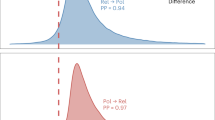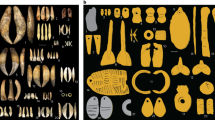Abstract
Over the past 2,000 years, Christianity has grown from a tiny Judaic sect to the world’s largest religious family1. Historians and social scientists have long debated whether Christianity spread through a top-down process driven by political leaders or a bottom-up process that empowered social underclasses2,3,4,5,6. The Christianization of Austronesian populations is well-documented across societies with a diverse range of social and demographic conditions7. Here, we use this context to test whether political hierarchy, social inequality and population size predict the length of conversion time across 70 Austronesian cultures. We also account for the historical isolation of cultures and the year of missionary arrival, and use a phylogenetic generalized least squares method to estimate the effects of common ancestry and geographic proximity of cultures8. We find that conversion to Christianity typically took less than 30 years, and societies with political leadership and smaller populations were fastest to convert. In contrast, social inequality did not reliably affect conversion times, indicating that Christianity’s success in the Pacific is not due to its egalitarian doctrine empowering social underclasses. The importance of population size and structure in our study suggests that the rapid spread of Christianity can be explained by general dynamics of cultural transmission.
This is a preview of subscription content, access via your institution
Access options
Access Nature and 54 other Nature Portfolio journals
Get Nature+, our best-value online-access subscription
$29.99 / 30 days
cancel any time
Subscribe to this journal
Receive 12 digital issues and online access to articles
$119.00 per year
only $9.92 per issue
Buy this article
- Purchase on Springer Link
- Instant access to full article PDF
Prices may be subject to local taxes which are calculated during checkout

Similar content being viewed by others
References
Johnson, T. M. & Grim, B. J. The World’s Religions in Figures: An Introduction to International Religious Demography (Wiley, Hoboken, 2013).
Deissmann, A. New Light on the New Testament: From Records of the Graeco-Roman Period (T. & T. Clark, Edinburgh, 1908).
Judge, E. A. The early Christians as a scholastic community. J. Relig. Hist. 1, 4–15 (1960).
Hopkins, K. Christian number and its implications. J. Early Christ. Stud. 6, 185–226 (1998).
Stark, R. The class basis of early Christianity: inferences from a sociological model. Sociol. Anal. 47, 216–225 (1986).
Stark, R. The Rise of Christianity (Princeton Univ. Press, Princeton, NJ, 1997).
Watts, J. et al. Pulotu: database of Austronesian supernatural beliefs and practices. PLoS ONE 10, e0136783 (2015).
Freckleton, R. P. & Jetz, W. Space versus phylogeny: disentangling phylogenetic and spatial signals in comparative data. Proc. R. Soc. B 276, 21–30 (2009).
Fox, R. L. Pagans and Christians (Penguin, London, 1986).
Barnes, T. D. Constantine and Eusebius (Harvard Univ. Press, Cambridge, MA, 1981).
Nietzsche, F. On the Genealogy of Morality: A Polemic (Hackett Publishing Company, Indianapolis, IN, 1998).
Muthukrishna, M., Shulman, B. W., Vasilescu, V. & Henrich, J. Sociality influences cultural complexity. Proc. R. Soc. B 281, 20132511 (2013).
Derex, M., Beugin, M. P., Godelle, B. & Raymond, M. Experimental evidence for the influence of group size on cultural complexity. Nature 503, 389–391 (2013).
Derex, M. & Boyd, R. Partial connectivity increases cultural accumulation within groups. Proc. Natl Acad. Sci. USA 113, 2982–2987 (2016).
Powell, A., Shennan, S. & Thomas, M. G. Late Pleistocene demography and the appearance of modern human behavior. Science 324, 1298–1301 (2009).
Henrich, J. Demography and cultural evolution: how adaptive cultural processes can produce maladaptive losses: the Tasmanian case. Soc. Am. Archaeol. 69, 197–214 (2004).
Aoki, K., Lehmann, L. & Feldman, M. W. Rates of cultural change and patterns of cultural accumulation in stochastic models of social transmission. Theor. Popul. Biol. 79, 192–202 (2011).
Rogers, E. M. Diffusion of Innovations (The Free Press, New York, NY, 1995).
Goodenough, W. H. Oceania and the problem of controls in the study of cultural and human evolution. J. Polyn. Soc. 66, 146–155 (1957).
Kirch, P. V. & Green, R. C. Hawaiki, Ancestral Polynesia: An Essay in Historical Anthropology (Cambridge Univ. Press, Cambridge, 2001).
Murdock, G. P. & Provost, C. Measurement of cultural complexity. Ethnology 12, 379–392 (1973).
Sahlins, M. D. Social Stratification in Polynesia (Univ. Washington Press, Seattle, WA, 1958).
Mace, R. & Pagel, M. The comparative method in anthropology. Curr. Anthropol. 35, 549–564 (1994).
Matthews, L. J., Passmore, S. H., Richard, P. M., Gray, R. D. & Atkinson, Q. D. Shared cultural history as a predictor of political and economic changes among Nation States. PLoS ONE 11, e0152979 (2016).
Lieber, M. in Exiles and Migrants in Oceania 35–67 (Univ. Press of Hawai’i, Honolulu, HI, 1977).
Keesing, R. Kwaio Religion: The Living and the Dead in a Solomon Island Society (Columbia Univ. Press, New York, NY, 1982).
McLaren, D. et al. Incorporating sociocultural beliefs in mental health services in Kwaio, Solomon Islands. Australas. Psychiatry 17, S125–S127 (2009).
Gilson, R. P. Samoa 1830–1900: The Politics of a Multi-Cultural Community (Oxford Univ. Press, Oxford, 1970).
Beatty, A. Society and Exchange in Nias (Clarendon Press, Oxford, 1992).
Gilson, R. & Crocombe, R. The Cook Islands 1820–1950 (Victoria Univ. Press, Wellington, 1980).
Stark, R. & Bainbridge, W. S. Networks of faith: interpersonal bonds and recruitment to cults and sects. Am. J. Sociol. 85, 1376–1395 (1980).
Efferson, C., Lalive, R., Richerson, P. J., McElreath, R. & Lubell, M. Conformists and mavericks: the empirics of frequency-dependent cultural transmission. Evol. Hum. Behav. 29, 56–64 (2008).
Mesoudi, A. & Lycett, S. J. Random copying, frequency-dependent copying and culture change. Evol. Hum. Behav. 30, 41–48 (2009).
Watts, J. et al. Clarity and causality needed in claims about Big Gods. Behav. Brain Sci. 39, e27 (2016).
Atkinson, Q. Q. D., Latham, A. A. J. & Watts, J. Are Big Gods a big deal in the emergence of big groups? Relig. Brain Behav. 5, 266–274 (2015).
Norenzayan, A. et al. The cultural evolution of prosocial religions. Behav. Brain Sci. 39, 1–86 (2014).
Diamond, J. Guns, Germs, and Steel: The Fates of Human Societies (W.W. Norton & Company, New York, NY, 1997).
Henrich, J. et al. Understanding cumulative cultural evolution. Proc. Natl Acad. Sci. USA 113, E6724–E6725 (2016).
Kline, M. A. & Boyd, R. Population size predicts technological complexity in Oceania. Proc. R. Soc. Lond. B 277, 2559–2564 (2012).
Collard, M., Ruttle, A., Buchanan, B. & O’Brien, M. J. Population size and cultural evolution in nonindustrial food-producing societies. PLoS ONE 8, e72628 (2013).
Collard, M., Buchanan, B., O’Brien, M. & Scholnick, J. Risk, mobility or population size? Drivers of technological richness among contact-period western North American hunter-gatherers. Phil. Trans. R. Soc. Lond. B 368, 20120412 (2013).
Read, D. An interaction model for resource implement complexity based on risk and number of annual moves. Am. Antiq. 73, 599–625 (2008).
Buchanan, B., O’Brien, M. J. & Collard, M. Drivers of technological richness in prehistoric Texas: an archaeological test of the population size and environmental risk hypotheses. Archaeol. Anthropol. Sci. 8, 625–634 (2015).
Vaesen, K., Collard, M., Cosgrove, R. & Roebroeks, W. Population size does not explain past changes in cultural complexity. Proc. Natl Acad. Sci. USA 113, E2241–E2247 (2016).
Mesoudi, A. Cultural Evolution: How Darwinian Theory Can Explain Human Culture and Synthesize the Social Sciences (Univ. Chicago Press, Chicago, IL, 2011).
Gray, R. D. & Watts, J. Cultural macroevolution matters. Proc. Natl Acad. Sci. USA 114, 7846–7852 (2017).
Gray, R. D., Drummond, A. J. & Greenhill, S. J. Language phylogenies reveal expansion pulses and pauses in Pacific settlement. Science 323, 479–483 (2009).
Sheehan, O., Watts, J., Gray, R. D. & Atkinson, Q. D. Coevolution of landesque capital intensive agriculture and sociopolitical hierarchy. Proc. Natl Acad. Sci. USA 115, 3628–3633 (2018).
Blomberg, S. P., Garland, T. & Ives, A. Testing for phylogenetic signal in comparative data: behavioral traits are more labile. Evolution 57, 717–745 (2003).
Kembel, S. W. et al. Picante: R tools for integrating phylogenies and ecology. Bioinformatics 26, 1463–1464 (2010).
Paradis, E., Claude, J. & Strimmer, K. APE: analyses of phylogenetics and evolution in R language. Bioinformatics 20, 289–290 (2004).
Dow, M. & Eff, E. Global, regional, and local network autocorrelation in the standard cross-cultural sample. Cross Cult. Res. 42, 148–171 (2008).
Atkinson, Q. D., Coomber, T., Passmore, S. H., Greenhill, S. J. & Kushnick, G. Cultural and environmental predictors of pre-European deforestation on Pacific Islands. PLoS ONE 11, e0156340 (2016).
Sookias, R. B., Passmore, S. H. & Atkinson, Q. D. Deep cultural ancestry and human development indicators across nation states. R. Soc. Open Sci. 5, 171411 (2018).
Greenhill, S. J., Blust, R. & Gray, R. D. The Austronesian Basic Vocabulary Database: from bioinformatics to lexomics. Evol. Bioinform. 4, 271–283 (2008).
R Core Development Team. R: A Language and Environment for Statistical Computing (R Foundation for Statistical Computing, 2015).
Revell, L. J. phytools: an R package for phylogenetic comparative biology (and other things). Methods Ecol. Evol. 3, 217–223 (2012).
Acknowledgements
The authors thank S. Passmore for assistance with the PGLS-spatial analyses, and A. Powell for comments. They also thank the John Templeton Foundation (28745), Templeton Religion Trust (TRT0153) and Marsden Fund (UOA1104) for funding. The funders had no role in study design, data collection and analysis, decision to publish, or preparation of the manuscript.
Author information
Authors and Affiliations
Contributions
J.W. and Q.D.A. designed the study. J.W. and O.S. developed the coding scheme and coded the data. J.W. ran the analyses. J.W. wrote the manuscript with input from all authors.
Corresponding author
Ethics declarations
Competing interests
The authors declare no competing interests.
Additional information
Publisher’s note: Springer Nature remains neutral with regard to jurisdictional claims in published maps and institutional affiliations.
Supplementary information
Supplementary Information
Supplementary Note, Supplementary Figure 1, Supplementary Tables 1–10, Supplementary References 1–184
Rights and permissions
About this article
Cite this article
Watts, J., Sheehan, O., Bulbulia, J. et al. Christianity spread faster in small, politically structured societies. Nat Hum Behav 2, 559–564 (2018). https://doi.org/10.1038/s41562-018-0379-3
Received:
Accepted:
Published:
Issue Date:
DOI: https://doi.org/10.1038/s41562-018-0379-3
This article is cited by
-
Cross-national analyses require additional controls to account for the non-independence of nations
Nature Communications (2023)
-
A phylogenetic analysis of revolution and afterlife beliefs
Nature Human Behaviour (2021)
-
Cultural evolutionary theory as a theory of forces
Synthese (2021)
-
Predicting societal-level cultural change
Nature Human Behaviour (2018)



